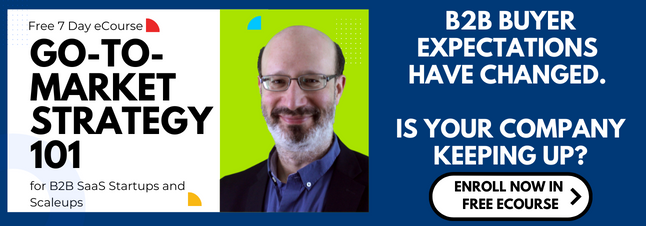Tech founders must juggle many competing priorities in the early stages of launching their startups. Hiring marketing and sales staff is often one of the biggest challenges and the most common decisions that founders get wrong.
In this video, you’ll learn why tech founders face such an uphill battle when hiring marketing and sales staff, how to resource to support the digital buyer’s journey more realistically, and what getting the hiring wrong looks like so you don’t make the same mistakes.
Go-to-market strategy and related marketing and sales playbooks
First up, tech startup founders -- and, for that matter, leaders of scaleups and small businesses -- need a firm grasp on how much buyer behavior has changed -- because it dramatically impacts go-to-market strategy and related marketing and sales playbooks.
- The latest research from Gartner found that 83% of a typical B2B purchase decision -- researching, comparing options, and evaluating pricing -- happens before a potential buyer engages with a vendor.
- And McKinsey & Company has discovered that 70% to 80% of B2B decision-makers now prefer to make decisions digitally.
- In its B2B Thought Leadership Impact Report, LinkedIn, in partnership with Edelman, concluded that “thought leadership remains critical to customer engagement but breaking through the noise is harder than ever.”
Digital buyer's journey
It’s also equally important to keep the buyer's journey in mind.
The buyer's journey Is the active research process that a potential customer goes through when they first start researching a goal, problem, or question and when that potential customer finally makes their purchase decision.
The buyer's journey has three stages:
- Awareness
- Consideration
- Decision
Most founders of tech startups, scaleups, and small businesses that struggle with their go-to-market strategy for the digital buyer’s journey have two big things in common:
- Overinvesting in the final 20% to 40% of the buyer’s journey (decision stage)
- Underinvesting in the first 60% to 80% of the buyer’s journey (awareness and consideration stages)
Overhiring in the decision stage
Regardless of whether you look at full-time equivalent headcount or total up salaries plus variable compensation, if your company is like most, it invests way more in the buyer's journey's final decision stage than the awareness and consideration stages combined.
Think of the Awareness stage as the first 50% of the buyer’s journey.
During the Awareness stage, your lead -- your potential customers -- is just becoming aware of a goal to achieve or a problem to solve.
Next, think of the Consideration stage as the next 30% of the buyer’s journey.
Within the Consideration stage, your lead -- your potential customer -- gives their goal or problem a more specific name or category. And that person begins to compare available different approaches.
Then, think of the Decision stage as the final 20% of the buyer’s journey.
During the Decision stage, your lead -- your potential customer -- can display some interest in speaking with a salesperson and becoming part of a sales opportunity.
Hiring the sales team
Most tech founders, even at a relatively early stage, hire a sales leader and sales team.
For illustrative purposes, a simple example may be a sales team of eight:
- 1 VP of sales
- 4 account executives
- 1 sales development manager
- 2 sales development reps
So, if you have eight employees working the Consideration stage of the buyer’s journey, the final 20% of the buyer’s journey, how many employees oversee your company’s role in the Awareness and Consideration stages of the buyer’s journey? Essentially the first 80% of the buyer’s journey?
If you’re like most tech founders, you’ll hire a mid-level marketing professional (marketing manager) to be solely responsible for the first 80% of the buyer’s journey -- and again, eight employees for the final 20% of the buyer’s journey.
Sales development rep (SDR) alignment and goals
And now, yes, good sales development reps (SDRs) and the sales development manager SHOULD be spending some time with leads -- potential customers -- in the Awareness and Consideration stages of the buyer’s journey.
How much time depends on how tight of a grip the VP of sales has around their time. In many environments, SDRs are all but forced to spend nearly all of their time working on leads that have the potential to close within the current month.
Marketing or sales activation
And in other kinds of toxic situations, marketing professionals get pulled off branding and demand generation projects and into sales activation activities. So nearly all of their time is spent accelerating existing pipelines that can be closed within the current month.
Customer success
Even Post-Purchase often gets way more headcount -- for example, a small customer success (CS) team -- than most tech founders allocate to the first 80% of the buyer’s journey.
Post-purchase is when a lead becomes a customer, goes through onboarding and begins seeing value from their purchase.
And yes, sure, post-purchase certainly matters. But most post-purchase problems start because sales teams close the deal with customers that didn’t get enough education and trust building before committing to your company.
And if you’re serious about What Tech Founders Get Wrong When Hiring Marketing and Sales...
Learn more when you enroll now in our free 7-day eCourse: Go-to-Market Strategy 101 for B2B SaaS Startups and Scaleups.



Submit a comment